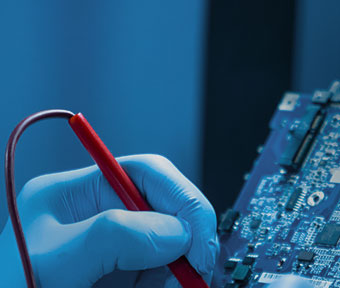High performance liquid chromatography, namely HPLC, is a well-known and efficient separation and analysis technology for free PEG and its PEGylated conjugate. Moreover, HPLC is also a powerful technique that can be used for the quantitative measurement of PEG, PEGylated small drugs, PEGylated liposomes and PEGylated micelles. Some features such as conjugate molecular weight, polymer mass distribution, or the degree and sites of PEGylation can be measured.
What is HPLC and Its Principle?
In the chromatographic column, the separation process is realized through the interaction among components of the mixture, the stationary phase and the mobile phase:
The stationary phase is an inert tube (column) packed with a very small porous powder, and the mobile phase is a solvent or mixed solvent that passes through the chromatographic column under high pressure. The sample is injected into the eluent before the column. When the sample is mixed with the mobile phase and passes through the chromatographic column at different rates, each component will flow out of the chromatographic column in turn due to the different adsorption capacity between the components and the stationary phase. Once separated, the component concentration could be converted into an electrical signal and transmitted to the computer software through a suitable detector, and the information you want can be obtained by analyzing the chromatogram curves.
PEG Analysis Services
HPLC for PEGylation Quantification
Because that PEGs do not contain active chromophores to be detected by UV light, the single HPLC cannot be able to assess the localization of PEG within the conjugates, but can be successfully utilized when coupled with other analytical tools, for example, refractive index detection (RID), mass spectrometry (MS), and the increasingly popular evaporative light scattering detection (ELSD). The grafting thickness can be estimated as half of the enlarged particle size compared to that of the non-PEGylated particles.
RID-HPLC
PEG molecules separated by HPLC can be directly measured with a RID, which has been commonly employed to measure PEG concentrations in urine samples during studies examining intestinal permeability. Size exclusion HPLC with RID can also be used to measure the content of residual PEGs in PEGylated protein samples.
UV-based HPLC
Although the sensitivity of PEG when detected by UV absorption is not comparable to that detected by RID, it still can be improved by some modification methods, such as link of the benzoate group. Moreover, UV-based HPLC can also be useful to measure incorporated drug concentrations in PEGylated liposomes or micelles. In comparison with fluorescent detection, UV-vis detection can help avoid potential interference and improve the accuracy.
HPLC-MS/MS
High-performance liquid chromatography coupled with tandem mass spectrometry (HPLC-MS/MS) allows sensitive quantitation of free PEG in biological fluid samples.
HPLC-ELSD
The only requirement of ELSD is that the conjugates or molecules should not evaporate under the set conditions, while the solvent evaporates. HPLC-ELSD is commonly used for analysis of compounds that do not efficiently absorb UV radiation.
LC-MS/MS
Utilizing some pretreatment steps before analysis, such as denaturation, alkylation, precipitation or solid phase extraction, can reduce the complexity of samples, thereby allowing LC-MS/MS become a more versatile tool for detection and identification of the positional isomers formed upon PEGylation.
HPLC is an excellent choice for the quantification of PEGylated drugs and small molecules. Although generally useful, the HPLC conditions and detection method must be optimized for each compound based on the chromatographic and spectral properties of the conjugated drug or small molecule.
Strengths & Weaknesses of HPLC
High-performance liquid chromatography (HPLC) analysis of polyethylene glycol (PEG) has several advantages and disadvantages:
Strengths
Sensitivity: HPLC is a highly sensitive technique that can detect low concentrations of PEG.
Selectivity: HPLC can separate PEGs of different molecular weights, providing detailed information about the components.
Speed: HPLC analysis of PEG is relatively fast and samples can be analyzed quickly.
Accuracy: HPLC can accurately quantify PEG, making it suitable for quality control purposes.
Reproducibility: If optimized properly, HPLC analysis can be highly reproducible, ensuring consistent results.
Weaknesses
Cost: HPLC equipment and consumables can be expensive, making them difficult to use for some laboratories.
Sample preparation: Sample preparation for PEG HPLC analysis can be time-consuming and complex, especially for complex matrices.
Limited information: While HPLC can provide detailed information about the composition of PEG, it may not provide information about other impurities or contaminants present in the sample.
Interference: HPLC analysis of PEG may be susceptible to interference from other compounds present in the sample, affecting the accuracy of the results.
Column Screening in HPLC Analysis of PEG
Protein drugs modified with PEG can prolong the residence time in the blood, inhibit the renal clearance rate, improve the solubility and stability of the drug, reduce immunogenicity and other beneficial effects. In particular, the effectiveness of drugs that incorporate branched PEG will be further improved. However, PEG-modified drugs will produce isomers due to different reasons such as the number or molecular weight of bound PEG and different binding sites. Therefore, in the development, production and quality control of such drugs, the separation and analysis of isomers by HPLC method is a very important part. Next, we list some application examples of TSKgel columns in the analysis of PEG-modified biopharmaceuticals.


